
Figure 1. Use Case Diagram of the Proposed System
The rail transportation system is crucial to the growth of any developing nation. Thus, there is a need to optimize the processes surrounding rail transportation, such as purchasing train tickets. The process of purchasing tickets manually at Nigerian railway stations is prone to ticket racketeering. Online ticketing systems have proven to be effective in other transportation systems such as the air transportation system. Therefore, implementing a web-based system for the ticketing process of rail transportation in Nigeria will solve the problem of ticket racketeering. The system is implemented using HTML, PHP, CSS, JQuery, JavaScript and Bootstrap with Quick Response (QR) codes for the process of ticket verification. Evidently, the system is reliable and recommended for use in ticket booking and reservation for rail transportation in Nigeria as it will contribute immensely to the economic growth of the country.
According to Agunloye and Oduwaye (2011) transportation is the mobility of people, goods, services and information by specific modes, some of which are roads, railways, airlines, and shipping lines. Each of these transportation modes supports the movement of people and goods from one place to another. Focusing on the land mode of transportation and especially the rail transportation system began in the mid-16th century in Germany in form of horse-powered funiculars and wagon ways. Railway reduces the cost of shipping and minimizes the loss of goods compared with water transportation, which is often characterized by ship mishap occasionally (Choudhary & Rao, 2018). Although the rail mode of transportation was thriving in developed countries, it was only adopted in Nigeria between 1898 and 1927, partly to maintain the connection between the central seat of colonial government in Lagos and other parts of the country. It was intended to set up the Nigerian Railway Corporation to engage in carriage of passengers and goods. So that it will offer full value for money, meet cost of operations, improve market share and quality of service, ensure safety of operations and maximum efficiency, meet social responsibility to meet the requirements of rail users, trade, commerce, industry, government and the general public (Agunloye & Oduwaye, 2011). The process of purchasing rail travel tickets in the Nigerian railway sector is experiencing major issues as ticket racketeering continues to be unabated at major train stations in Nigeria, so that large crowds of passengers struggle to get on board (Igidi et al., 2019). This is because railway travel tickets are manually booked and reserved, leading to sharp practices on the part of the authorities and middle men. This calls for the adoption of information technology-based solutions. This is the gap that this research aims to provide solutions by designing and implementing an e-ticketing booking and reservation system for rail transportation using QR codes verification method for booking and payment. This is because the automation of the system will entrench accountability and transparency, thus boosting the economy of the country.
Rail transportation is a way of moving passengers and goods on wheeled running on rail, also referred to as tracks. Tracks usually consist of steel rails, installed on ties (sleepers) and ballast. Rail transportation commenced in mid-16th century in Germany. Modern rail transportation began with the British introduction of the steam powered locomotives in the early 19th century. The railway system in Great Britain is adjudged as the oldest in the world history. It was manufactured by George Stephenson and his son Robert (Robert Stephenson and company). Moreover, locomotion No.1 was the first steam locomotive-powered to convey passengers on the public rail line, the Stockton and Darlington in 1825. In addition, George manufactured the first public intercity railway line in the world history to use only the steam locomotives all the time, the Liverpool and Manchester Railways was commissioned in 1830. Steam engines are the critical component of the industrial revolution. Railway transportation carries a large number of people and large quantity goods at a reduced cost and causes minimal loss and damage to goods as compared to other transportation. The proliferation of the railway network and the use of railway timetables give rise to the standardization of time (Railway time) in Britain based on Greenwich Mean Time. The invention and development of the railway in the UK was one of the critical technological breakthrough of the 19th century (Choudhary & Rao, 2018).
The Nigerian Railways came into existence on 3 October, 1912 by the merger of Lagos Government Railways and Baro-Kano railway. It however, became an autonomous public corporation by an Act of parliament called the Nigeria Railway Corporation (NRC) Act (1955), amended in 1990. The Nigerian Railway networks runs diagonally from the Southwest (Lagos) to Northeast (Nguru) and from the South-East (Port-Harcourt) to through Kafanchan to North-East (Maiduguri). The Network consists of 4332 track kilometres characterized by sharp curves and steep gradients in some sections. Apart from Kafanchan-Maiduguri, which was constructed between 1954 to 1964, most of the network tracts were constructed between 1898 and 1927. Not much has been done in the construction of the new rail line since 1964 (Bureau of Public Enterprises, 2018). According to the Punch News paper (1971 - 2020) , fifty years after independence, Nigeria is still struggling to operate a part of the 3,505km of railway inherited from British colonial masters amid failed numerous contracts. The Nigeria Railway Corporation was credit to have performed reasonably well between 1955 and 1979. But there was a steady decline in the late 1970s. Although the successive government is concerned about the parlous state of the nation's railway system by allocating funds to turn around this major important transport mode, which does not translate into desirable improved train services. This was attributed to lack of maintenance, policy inconsistency, corruption, management inefficiency and inadequate marketing (The Punch Newspaper, 1971-2020; Leadership Newspaper Nigeria, 2018). Considering the importance of functional rail system to the economic development of a country, the Federal Government of Nigeria is working out plans to revolutionize the sector (Leadership Newspaper Nigeria, 2018). Although the old Lagos-Kano rail line was inaugurated in 21 st December, 2012 after its rehabilitation, the rehabilitation of Port- Harcourt-Maiduguri is ongoing, with Abuja-Kaduna Mass Transit trains Lot 1 and Lot 2 already completed and th inaugurated by President Muhammadu Buhari on 26 July, 2016 (Barrow, 2016). Commissioning of Lagos- Ibadan standard Gauge Mass Transit train by the Vice th President Yemi Osinbajo on the 8 of February, 2019 and many ongoing railway rehabilitation and construction of new rail lines will link the North and South, East and Western part of the country (Aliyu, 2019).
Quick Response codes (QR-Codes) were first created in 1994 by Denso Wave Incorporated, Japan. Denso Wave is the parent company of Toyota. QR code is a machine readable optical label with information on the associated item or product. Unlike the conventional barcode where information is coded only in one direction or one dimensional. In the other hand, QR code is twodimensional, in which the information is coded in two directions: vertically and horizontally. QR code can provides up to a hundred times more information than barcodes and it can manage all types of data: letters, numbers, graphics and audio or video files. It can encode up to 7000 characters compared to conventional barcodes that stores only 20 digits. Information can be viewed from different directions in QR codes (360 degrees) (Chang, 2014).
The implemented system (Rani & Rajan, 2018) is a completely electronic and automated ticket booking system, in which reservation is carried out by means of finger print sensor and implemented using Peripheral Interface Controller (PIC). The implemented system employed the methodology such as image processing using MATLAB for image acquisition, image analysis and control machine. Its advantages include the use of minutia approaches which employs characteristics such as ridge bifurcation to plot points on a fingerprint, accurate system recognition and quick identification of fingerprint. A major weakness of this system is not integrating the Aadhar card system, which holds the details of every Indian citizen, making the process of purchasing tickets and verifying tickets inefficient.
The application was implemented (Pothineni et al., 2018) in the perspective of user convenience and a user friendly interface which helps users without any complicated searching of process. The Railway Reser vation application employed therapid application development process, model which is an incremental model. The major functions of the system were acquiring and monitoring the major issues of user while booking or any other query such as the cancellation, passenger name record (PNR) status, live status of train, and train information. The system provides ease but does not solve the existing problem of black marketing of tickets by third party vendors facing the Indian Railway System.
Mallikarjuna et al. (2018) exploits the opportunities created by industrial Internet of Things (IoT). It focuses on the survey of different communication technologies under the paradigm of IoT. Using the Aadhar number in India's Unique Identification Authority of India (UIDAI) and the replacement of present 4G network of the Indian reservation system to GSM-R, 5G, LTE and IEEE 802.11, the survey proved the effectiveness of IoT to the present Indian Railway Reservation System. However, the use of IoT and other stated technologies is more resource intensive.
Ganapathi et al. (2018) developed a web application in Java JSP technology, which is integrated with the Unique Identification Authority of India (UIDAI) Aadhar system and also a mobile application. Through the web application integrated with UIDAI Aadhar system, passengers can book tickets using biometrics as the primary key without the need of entering other details, and verification of tickets confirmed by the mobile application using an external fingerprint sensor or an inbuilt sensor with each railway official having login credentials. The system is expected to solve the problem of refund of money to passengers who do not get to travel and also the allocation of seats to passengers on the waiting list.
The proposed system (Jha et al., 2018) includes a web application and a fingerprint reader based on a Unique Identification (UID) technology, which is applicable for booking rail tickets and managing travel database for convenience and transparency. The system uses Aadhar database for user verification. The verified user can add money to the system's in-built wallet, which will automate the ticket booking process. The user then provides thumb impression at the source and at the destination station after checking out. The proposed system provides a secured way to travel by trains, reducing the huge amount of time consumption by avoiding the rush for ticketing. This system however increases the waiting time when carrying out fare deduction making the system inefficient.
The proposed system (Vanitha et al., 2018) contains five modules, which includes the Aadhar based Ticket Reservation System, Ticket Checker Application, Location Application, Biometric validation and Destination check and notify Train Ticket Examiner (TTE) module. Biometric check and validation of each passenger with the help of Aadhar database and a fingerprint scanner will take place at the entrance and exit of each compartment of the train. In event of tickets mismatch an alarm raised and alert message is sent to Train Ticket Examiner. Using a GPS receiver on the train, location can be tracked and the source and destination of the passenger can be authenticated or validated. Implementing this system will require a lot of resources which are expensive.
The purpose of the proposed system is to provide an efficient ticket booking, where in each passenger has equal rights to avail the ticket to minimize the ticket racketeering and sharp practice (Priyanka et al., 2017). This system integrates the Aadhar card system with the railway system to restrict the direct reservation of tickets by making the Aadhar ID as the mandatory factor for booking. Using Aadhar ID, the proposed system will reduce the ticket black-marketing and corruption in the railway system. The proposed system is focused only on booking and for the system using many resources, other features such as payment and reservation cancellation were not included.
Khan (2017) proposed the alternative solution for Indian railway passengers who make reservation but do not get the confirm ticket. The proposed system will employ a cloud computing and cluster data mining technique to the existing railway reservation system to solve problems encountered by passengers who stay on the waiting list but never get a confirm ticket after reservation has been made. It will also help Travelling Ticket Examiner (TTE) to identify vacant seats as quickly as possible in order to allocate tickets to passengers on the waiting list. However, the proposed system will not solve problems regarding the ordering and purchasing of tickets.
From the aforementioned literatures review, there is no research or framework that uses QR codes to tackle ticket racketeering in railway ticket purchase for booking and reservation. This is the gap that this research aims to bridge.
The proposed system is a web-based e-ticketing application that will be implemented using web technologies such as Hypertext Preprocessor (PHP) and Hypertext Markup Language (HTML) for defining the user interface, application logic and database interaction. For the purpose of development and demonstration, the database will be running on a local host server which consists of Apache Server and mySQL Server. QR-code scanner will made available on any mobile application operating system for ticket verification purpose. The web application will be responsible for showing train schedules, reservations, providing payment option for tickets to be purchased, providing a refund option for canceling reservation and also generates QR-code from the uniquely generated code. The QR-code scanner, already developed, will serve as a ticket checking device to verify the genuineness of the ticket submitted by passengers at the train station. The proposed system is designed for use in Nigerian Railway Transportation ticketing system.
The proposed system will be implemented for adopting the following modules:
Figure 1 represents the use case diagram that illustrates the web-based e-ticketing system for Nigerian railway system. The system comprises of four (4) actors. The first actor is the passenger who checks train schedules and then signs up as a new user of the system or login if the passenger is already an existing user. This grants access to the passenger to make reservations, make payment for tickets and also print the soft copy of the ticket generated by the system along with the QR-code upon payment. The second actor is the super administrator, the job of the administrator is to create other administrators while the third actor which is the administrator update train schedules and view train reservations. The fourth actor who is the last actor has a job of just verifying ticket as either valid or invalid.

Figure 1. Use Case Diagram of the Proposed System
A deployment diagram is a Unified Modeling Language (UML) diagram that shows the execution architecture of a system, including nodes such as hardware and software execution environments and the middleware connecting them. Deployment diagrams are typically used to visualize the physical hardware and software of the system. Figure 2 shows the architecture of the system in • order to understand how the proposed system will be physically used. The passengers can have access to the system using their preferred computing device to check train schedules, after which passengers can login to the system from the home page with their login details verified by the server to grant passengers access to other functionalities such as making reservations, making payment for reservation made, save or print generated ticket which is then taken to the train station and verified by ticket checkers at the train station. The super administrator logs into the system to create other administrators, while the created administrators update train schedules and view train reservations.

Figure 2. System Architecture
An activity diagram is a flow chart that represents the flow from one activity to another. The activity can be described as an operation of the system. Figure 3 shows the proposed system activity diagram. Before accessing the system, passengers can check the train schedules which is then required to sign up and present valid login credentials to the system. After the authentication process, authorized users such as passenger, admin and super admin are granted access to appropriate resources in the proposed system. For the passenger, this includes making train reservations and making payment for reservation made. The super administrator manages administrator while the administrator provides and updates train schedules. The ticket checker accesses the system upon the verification of tickets with QR code.

Figure 3. Activity Diagram
This section describes the menus available to users / travelers of the e-ticket system, allowing them to enter the system and perform the necessary functions.
The registration page shows how new users of the implemented system will be registered, the registration page collects users details and stores it in the database. These details include first name, last name, email and phone numbers. Figure 4 shows the registration page.

Figure 4. User Registration Page
Figure 5 is the page for the registration of passenger next of kin which provides the train station staff with the information needed to contact the passenger's close relatives in the event of any problem encountered during course of the journey.

Figure 5. Passenger Next of Kin Registration Page
This page shows the schedule timetable of every train station, the moving pattern, the start and stop point of each train, time for every journey and prices. Figure 6 shows the train schedule page.

Figure 6. Schedule Page
Figure 7 shows the login page that allows users to enter already registered details such as the users email and password in order to grant access to already registered users to the implemented system, when verified against the content of the database grants or revokes access to the functionalities.
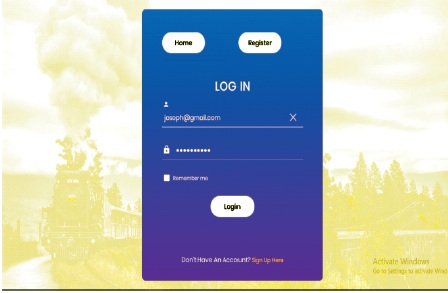
Figure 7. User Login Page
After a user is successfully logged into the system, access is granted to the user to make use of reservation functionality. This page requires the user to enter travel details to make necessary reservation for travel. These details includes the user's destination, trip type and also specifies if the trip is for a single or multiple persons. Figure 8 shows the reservation page of the system.
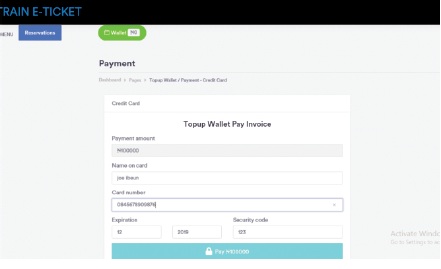
Figure 8. Reservation Page
The payment page allows user to select the preferred payment method to make payment for reservations made. Figure 9 shows a user selecting the e-wallet payment method to make payment for reservations made. Once the payment is done, amount will be deducted from the wallet and an e-ticket will be generated for the user.
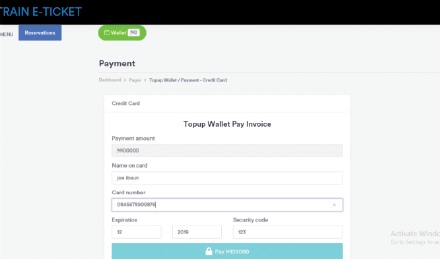
Figure 9. Wallet Payment System
Figure 10 shows a picture of the electronic ticket issued to the user after payment is done. This ticket contains every travel details of the user and also a QR-code which will be scanned at the train station for the validity of tickets. This ticket can be saved on the user device or the user can only print the QR-code
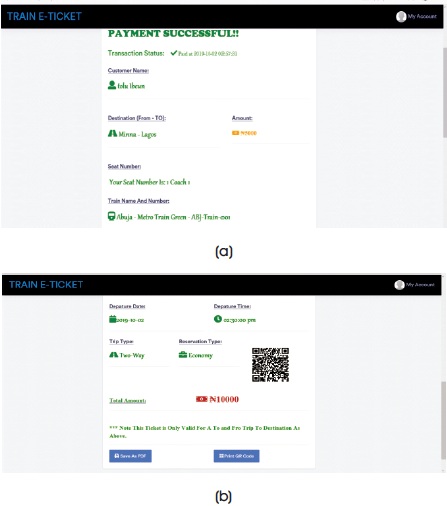
Figure 10. (a,b) Electronic Ticket
The administrator's page requires an administrator to login which grants access to manage train activities. Figure 11 above shows an administrator's login page.
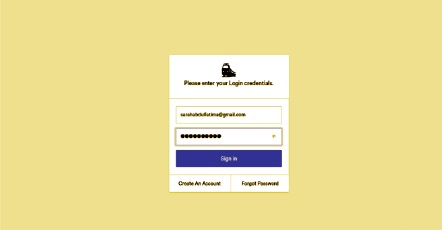
Figure 11. Administrators Login Page
System testing is a software testing where complete and integrated software is tested. The resolve of this test is to evaluate the system's compliance based on some usability criteria to ensure user satisfaction with the implemented system. The implemented system was tested for usability by presenting the system to 5 web developing experts in 3 from the department of Computer Science, Federal University of Technology, Minna, Nigeria and 2 from the department of Information and Media Technology from the same University to validate, 15 users where selected at random and they comprise of rail travelling passengers and tickets issuers and checkers at Minna Railway Station, Minna, Nigeria. The responses from the users (respondents) were collated based on usability criteria such as readability, navigability, speed, task success, user satisfaction design and accessibility. The respondents responses were rated based on the following parameters: Strongly Disagree (SD), Disagree (D), Neither Disagree or Agree, Agree and Strongly Agree.
From Table 1, 15 respondents strongly agreed with the navigability of the system, 2 agreed while 3 neither agreed or disagreed with the navigability of the system. 11 respondents strongly agreed with the speed and efficiency of the system, 8 agreed and 1neither agreed nor disagreed. 12 respondents strongly agreed with the task success of the system, 6 agreed and 3 neither agreed nor disagreed. Moreover, 10 respondents strongly agreed with the user-friendliness of the system, 7 agreed and 2 neither agreed nor disagreed and 1 respondent disagreed 12 respondents strongly agreed with the accessibility of the system, 7 agreed and 1neither agreed nor disagreed. Lastly, 9 respondents strongly agreed with the readability of the system, 6 agreed and 4 neither agreed nor disagreed while 1 did not agreed. From the above analysis, it can be deduced that the tested system has proven to be efficient and reliable for use in Nigeria Railway Transportation e-Ticketing system and it can be applied or replicated for use in any similar situation anywhere in the world.
The system usability chart (histogram)shown in Figure 12, depicts graphically the analysis in Table 1.
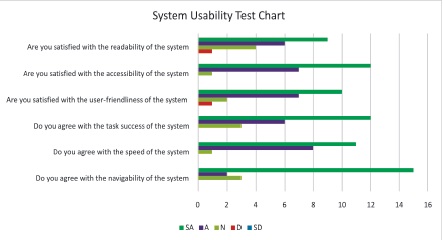
Figure 12. Usability Test Chart
A web-based e-ticketing booking and reservation system using QR-codes was implemented to curb ticket racketeering in Nigerian Rail Transportation sector. The use of technology-based solutions to the ticketing system in the Nigerian railway sector will bring about unprecedented economic growth and provide solutions to long lasting problems, such as racketeering and diversion of public funds. In addition, the system is also reliable as it can be replicated in railway transportation ticketing system in any part of the world. The implemented web-based e-ticketing system for the railway sector will help generating revenue for the government and thereby reform the Nigerian economy.
The implemented system is recommended for use as it has proven effectiveness and efficiency in tackling ticket racketeering in Nigerian Railway Transportation. Intending railway traveling passengers are therefore recommended to adopt the implemented system to make their bookings and reservations online from the comfort of their homes or offices regardless of their location without subjecting themselves to queuing for ticket uncertainties and stress.
Future work can focus on adding functionalities to the system that will offers railway travelling passengers the platform to express satisfaction/dissatisfaction with the services delivered to them by the Nigerian Railway Corporation. In addition, a platform or functionality could also be added to tackle passengers' complaints, such as lost baggage, uncomfortable seat, delay in train take off and late arrival, hidden charges, terms and conditions among others.